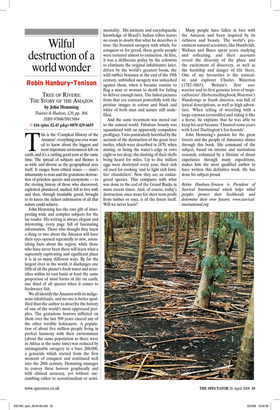Wilful destruction of a world wonder
Robin Hanbury-Tenison
TREE OF RIVERS: THE STORY OF THE AMAZON by John Hemming Thames & Hudson, £20, pp. 368, ISBN 9780670915804 ✆ £16 (plus £2.45 p&p) 0870 429 6655 This is the ‘Compleat History of the Amazon’: everything you ever wanted to know about the biggest and most important environment left on earth, and it’s a rattling good yarn at the same time. The spread of subjects and themes is as wide and diverse as the geographical area itself. It ranges from ethical issues — man’s inhumanity to man and the gratuitous destruction of priceless species and ecosystems — to the riveting history of those who discovered, exploited, plundered, studied, fell in love with and then, through insatiable greed, brought to its knees the richest culmination of all that nature could achieve.
John Hemming has the rare gift of interpreting wide and complex subjects for the lay reader. His writing is always elegant and interesting, every page full of fascinating information. Those who thought they knew a thing or two about the Amazon will have their eyes opened repeatedly to new, astonishing facts about the region; while those who have never been there will learn what a supremely captivating and significant place it is in so many different ways. By far the largest river in the world, it discharges one fifth of all the planet’s fresh water and nourishes within its vast basin at least the same proportion of most forms of life on earth; one third of all species when it comes to freshwater fish.
We all identify the Amazon with its indigenous inhabitants, and no one is better qualified than the author to describe the history of one of the world’s most oppressed peoples. The gratuitous horrors inflicted on them over the last 500 years exceed any of the other terrible holocausts. A population of about five million people living in perfect harmony with their environment (about the same population as there were in Africa at the same time) was reduced by unimaginable savagery to a bare 200,000, a genocide which started from the first moment of conquest and continued well into the 20th century. Hemming manages to convey these horrors graphically and with clinical accuracy, yet without succumbing either to sensationalism or senti mentality. His intimate and encyclopaedic knowledge of Brazil’s Indian tribes leaves no room to doubt that what he describes is true: the frenzied savagery with which, for conquest or for greed, these gentle people were tortured almost to extinction. At first, it was a deliberate policy by the colonists to eliminate the original inhabitants; later, driven by the world’s greatest boom, the wild rubber bonanza at the end of the 19th century, unbridled savagery was unleashed against them, when it became routine to flog a man or woman to death for failing to deliver enough latex. The faded pictures from that era contrast powerfully with the pristine images in colour and black and white of both man and nature still undefiled.
And the same treatment was meted out to the natural world. Fabulous bounty was squandered with an apparently compulsive profligacy. I was particularly horrified by the account of the destruction of the great river turtles, which were described in 1870, when mating, as lining the water’s edge in rows eight or ten deep, the clashing of their shells being heard for miles. Up to five million eggs were destroyed every year, their rich oil used for cooking ‘and to light rich families’ chandeliers’. Now they are an endangered species. This compares with what was done to the cod of the Grand Banks in more recent times. And, of course, today’s destruction, once more for short term profit from timber or soya, is of the forest itself. Will we never learn? Many people have fallen in love with the Amazon and been inspired by its richness and beauty. The world’s preeminent natural scientists, like Humboldt, Wallace and Bates spent years studying and collecting, and their accounts reveal the diversity of the place and the excitement of discovery, as well as the hardship and danger of life there. One of my favourites is the naturalist and explorer Charles Waterton (1782-1865), ‘Britain’s first ecowarrior and its first genuine lover of tropical forests’. His bestselling book, Waterton’s Wanderings in South America, was full of lyrical descriptions, as well as high adventure. When telling of wrestling with a large cayman (crocodile) and riding it like a horse, he explains that he was able to keep his seat because ‘I hunted some years with Lord Darlington’s fox hounds’.
John Hemming’s passion for the great forests and the people of Amazonia shines through this book. His command of the subject, based on intense and meticulous research, enhanced by a lifetime of direct experience through many expeditions, makes him the most qualified author to have written this definitive work. He has done his subject proud.
Robin Hanbury-Tenison is President of Survival International which helps tribal peoples protect their livelihoods and determine their own futures. www.survivalinternational.org










































































 Previous page
Previous page